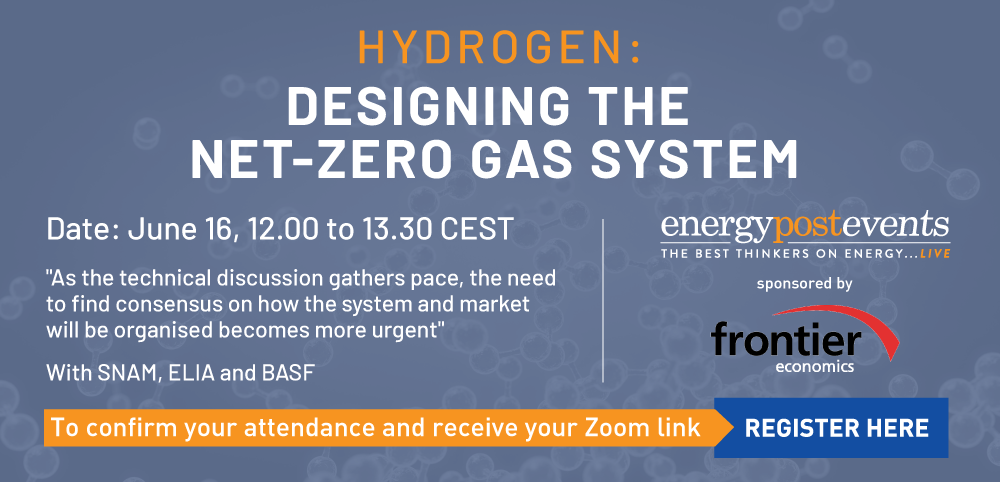
BACKGROUND:
Accommodating hydrogen and other renewable and decarbonised gases in the gas system could offer an answer to the issue of longer-term flexibility in the power system. At the same time, it could deliver a net-zero feedstock to industry using existing, perhaps modified, infrastructure and specially developed clusters.
As the technical discussion gathers pace, the need to find consensus on how the system and market will be organised becomes more urgent.
Building on recent work in the area, Energy Post and Frontier Economics are delighted to host a panel of key experts to examine the options. A shared, viable vision – established sooner rather than later – will help investors, policymakers and regulators ensure Europe’s gas system is on a straight, sustainable road to net-zero.
The gas system will enable decarbonisation and energy system integration
Both the EU and UK are committed to reducing net greenhouse gas emissions to zero by 2050. But the gas system can still play an important role:
- First, by shifting from natural gas to renewable and low-carbon gases, especially in “hard-to-abate” sectors such as industry and (particularly heavy duty) transport.
- Second, by coupling the existing gas transportation, distribution and storage systems to the electricity system using Power-to-Gas technologies to absorb surplus electricity generated from RES-E and as a means of seasonal storage and transportation of renewable and low-carbon energy.
The spotlight is on hydrogen
The future will see a mix of different renewable and low-carbon gases being used. Biomethane is already being injected into the gas grid and its use will increase.
Hydrogen has captured attention in recent years. Clean hydrogen production has the potential to be more easily scaled up than biomethane. It might be used across a range of applications. But a more widespread use of hydrogen would require repurposing of existing gas infrastructure or potentially new dedicated hydrogen infrastructure. Alternatively, hydrogen might be blended with methane in existing natural gas pipelines.
Policymakers are already considering how to overcome the infrastructure challenge
Policymakers across Europe are considering two sets of (interlinked) issues in relation to the regulation of hydrogen infrastructure. Broadly these are:
- Hydrogen infrastructure regulation: ensuring the right pipelines are delivered, in the right places, cost-effectively. A key question regarding dedicated hydrogen infrastructure is how to finance the up-front investment costs of building or re-purposing new networks.
- The commercial framework for hydrogen: making efficient use of existing infrastructure and ensuring the balance between supply and demand (both at an overall level in the gas system, and in particular parts of the network). While the commercial framework for dedicated hydrogen infrastructure could operate along similar lines to that in place today for natural gas, that for blended networks will involve more complex design.
AGENDA:
Resolving these questions requires a shared understanding of how the European system might evolve
While infrastructure needs are driven by the location of supply relative to demand, infrastructure availability can itself influence where production and consumption takes place. This creates a path dependency: decisions made in the next few years regarding gas infrastructure will have a bearing on the eventual cost-effectiveness of the energy transition.
But making the ‘right’ decisions on infrastructure is not simple. The panel will discuss:
- What type of infrastructure will be required (dedicated or blended)? Many customers might be able to cope with hydrogen blends. But some (industrials which are the large consumers and those with the largest GHG emission reduction potentials in particular) may be more sensitive to the level of hydrogen blends as well as to changes in the hydrogen blend over time. Technological progress, such as e.g. cheap(er) de-blending, might become an additional game-changer over time. System planners need to consider where it might be best to put in place dedicated hydrogen infrastructure and where hydrogen production can be integrated into the methane system.
- What happens to the gas market if different countries take wildly differing approaches to hydrogen blending? The European gas system is highly interconnected. What if decisions on choices between dedicated hydrogen infrastructure and methane infrastructure are not coordinated?
Such examples highlight the need for a common European vision on how the gas system might best support decarbonisation, and what this means for infrastructure planning and use. Questions to resolve might include:
- Technological and infrastructure implications: What are the technical limits for the integration of hydrogen into the EU gas infrastructure and how can they be overcome? What are the implications for existing pipelines and LNG terminals?
- Models for system design: Will clean hydrogen mainly be imported from abroad and will demand for it be distributed throughout Europe, implying a similar high level of cross-border flows to today? Or will clean hydrogen mainly be produced domestically? If so, where will it be produced – at distribution level, in industrial clusters? And what are the implications for hydrogen either flowing through dedicated infrastructure or being blended into the methane grid?
- Governance and regulatory implications: How to decide between the different models? What are the implications of the different models from a cost, time and decarbonisation perspective (and is there a consistent way of evaluating trade-offs between these models)? What strategic decisions need to be taken regarding use of infrastructure and what flexibility can be left with the market? Can different national regional approaches co-exist or does there need to be one, harmonised approach?
PANELLISTS

Catherine Galano
Associate Director, FRONTIER ECONOMICS (moderator)
Catherine advises on strategy, regulatory and policy issues across sectors, focusing on energy and transport.
She is experienced in market design, price controls, competition, sale and acquisition of assets, and policy evaluation. She draws from a range of techniques including incentive design, cost of capital estimation, economic modelling and cost-benefit analysis

Jochen Wagner
Team Lead Energy & Utilities EU / Procurement & Regulatory Affairs, BASF
Chemical engineer taking care of all energy supplies to >100 sites in Europe, being also responsible for regulatory affairs. Heading several national and European working groups for natural gas, representing Cefic and/or IFIEC e.g. in the Madrid Forum or CEN

Giulia-Maria Branzi
Head of Climate Policies, SNAM
Giulia Branzi is the Head of Climate Policies at SNAM, one of the world’s leading energy infrastructure operators and one of the largest Italian listed companies in terms of market capitalization. Prior to joining SNAM, Giulia has worked as a regulatory economist for the UK water and energy regulators Ofwat and Ofgem, as well as at the European Bank for Reconstruction and Development, covering energy policy and regulatory issues across the Bank’s Countries of Operation in Central Asia.

Nicolas Gielis
Head of Strategy, ELIA
Nicolas worked for 11 years at Fluxys (Belgian gas TSO), first as project manager for infrastructure projects, later as head of innovation (supporting the development of renewable gases, amongst which: hydrogen). Two years ago, joined the Elia Group as Strategy manager, working mainly on digitalisation, offshore and hydrogen

Walter Boltz
Senior Advisor European Energy - Walter Boltz Consulting
Walter is a Senior Advisor for European Energy issues, member of the ACER Board of Appeal, the ERRA Strategic Advisory Council as well as of the EPRI Advisory Council. He has extensive experience in all aspects of electricity & gas markets as well as in the area of regulation of the energy sector. Walter was the Chairman of the Supervisory Board of JSC MGU, the owner of the Ukrainian Gas TSO, GTSOU LLC, and implemented the unbundling between 2018 and May 2020.


